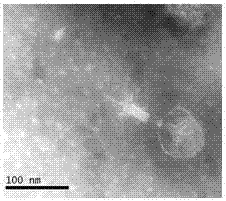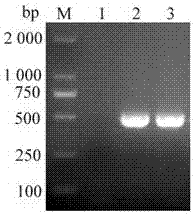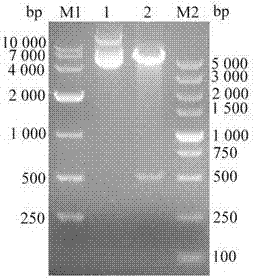Preparation method of bacteriophage lyase capable of lysing escherichia coli and salmonella
A technology of phage lysing enzyme and Escherichia coli, which is applied in the field of animal biomedical engineering, can solve the problems of difficult prevention and control of Escherichia coli infection, and achieve the effect of not easy denaturation of target protein, easy operation and low cost
- Summary
- Abstract
- Description
- Claims
- Application Information
AI Technical Summary
Problems solved by technology
Method used
Image
Examples
Embodiment 1
[0038] Example 1 Construction of Escherichia coli BL21 expression strain containing lysin gene
[0039] Include the following steps:
[0040] S1. Construction of recombinant plasmid pET-32a-lysin
[0041] S11. Acquisition of lysin gene: A phage that can lyse both E. coli and Salmonella was isolated from domestic sewage (named ECGD1, see its electron micrograph figure 1 ), extract the genome of the phage after a large number of cultures, and perform high-throughput sequencing and splicing and analysis of the sequencing results.
[0042] Extraction of bacteriophage ECGD1 genome: take 600 μl of phage concentrate after filter sterilization, add DNase I and RNase A to a final concentration of 1 μg / ml, digest overnight at 37°C (to completely remove host bacterial nucleic acid), inactivate at 80°C 15 min (note: this temperature cannot inactivate RNase A); add 24 μl of 0.5 mol / L EDTA (final concentration 20 mmol / L) and 1.5 μl of 20 mg / mL proteinase K (final concentration 50 μg / mL...
Embodiment 2
[0053] Example 2 Activity detection of recombinant protein TrxA-lysin
[0054] Include the following steps:
[0055] S1. Cleavage of chloroform-pretreated DH5α with recombinant protein TrxA-lysin: Inoculate the strain to be tested in LB medium at a ratio of 1%, culture overnight, add 5% chloroform to the bacterial solution, and shake for 15 min , collected by centrifugation, washed twice with deionized water, and stored at -80°C for later use. Before measuring the activity, the bacterial pellet was resuspended with 50 mmol / L Tris-HCl (pH 8.2, containing 0.1% Triton X-100). Add 10 µL of lysing enzyme solution (recombinant protein TrxA-lysin solution) to 90 µL of bacterial suspension, let it stand at room temperature until the lysis effect is obvious, and measure the OD 450 . The experiment was repeated three times, and Tris-HCl buffer was used as a negative control. Since phage ECGD1 can lyse Escherichia coli genetically engineered strain DH5α, DH5α was first used as the te...
PUM
 Login to View More
Login to View More Abstract
Description
Claims
Application Information
 Login to View More
Login to View More - R&D
- Intellectual Property
- Life Sciences
- Materials
- Tech Scout
- Unparalleled Data Quality
- Higher Quality Content
- 60% Fewer Hallucinations
Browse by: Latest US Patents, China's latest patents, Technical Efficacy Thesaurus, Application Domain, Technology Topic, Popular Technical Reports.
© 2025 PatSnap. All rights reserved.Legal|Privacy policy|Modern Slavery Act Transparency Statement|Sitemap|About US| Contact US: help@patsnap.com



